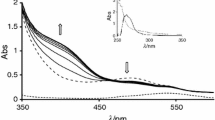Abstract
The complex formation equilibria of [Pd(FLX)(H2O)2]2+, where FLX = the drug fluoxetine, with the bio-ligands (L), glycine, serine, cysteine, histidine, glycylglycine and glycylvaline, were studied and their formation constants were determined. Stoichiometries and stability constants of the complexes were determined at 25 °C and at constant 0.10 mol·dm−3 NaNO3 ionic strength. The concentration distribution of the complexes in solution was evaluated. Palladium(II) complexes were synthesized and characterized by the 1H NMR and electronic spectral studies. The structures consist of monomeric units in which the Pd(II) atoms exhibit square planar geometry.





Similar content being viewed by others
References
Frick, L.R., Palumbo, M.L., Zappia, M.P., Brocco, M.A., Cremaschi, G.A., Genaro, A.M.: Inhibitory effect of fluoxetine on lymphoma growth through the modulation of antitumor T-cell response by serotonin-dependent and independent mechanisms. Biochem. Pharmacol. 75, 1817–1826 (2008)
Farrell, N.P.: Transition metal complexes as drugs and chemotherapeutic agents. In: James, B.R., Ugo, R. (eds.) Catalysis by Metal Complexes, vol. 11. Reidel-Kluwer Academic Press, Dordrecht (1989)
Farrell, N.P.: The Uses of Inorganic Chemistry in Medicine. The Royal Society of Chemistry, Cambridge (1999)
Orvig, C., Abrams, M.J.: Medicinal inorganic chemistry: introduction. Chem. Rev. 99, 2201–2204 (1999)
Guo, Z., Sadler, P.J.: Metals in medicine. Angew. Chem. Int. Ed. 38, 1512–1531 (1999)
Keppler, B.: Metal Complexes in Cancer Chemotherapy. VCH, Basel (1993)
Clarke, M.J.: Progress in Clinical Biochemistry and Medicine, vol. 10. Springer, Berlin (1989)
Fricker, S.P. (ed.): Metal Complexes in Cancer Therapy, vol. 1, p. 215. Chapman and Hall, London (1994)
Berthon, G.: Handbook of Metal–Ligand Interactions in Biological Fluids, vols. 1 and 2. Marcel-Dekker Inc., New York (1995)
Clarke, M.J., Sadler, P.J. (eds.) Metallopharmaceuticals I: DNA Interactions, vol. 1, p. 199. Springer, Berlin (1999)
Zhang, C.X., Lippard, S.J.: New metal complexes as potential therapeutics. Curr. Opin. Chem. Biol. 7, 481–490 (2003)
Roat, R.M.: Bioinorganic Chemistry: A Short Course. Wiley Interscience, Hoboken (2002)
Shishkina, G.T., Dygalo, N.N., Yudina, A.M., Kalinina, T.S., Tolstikova, T.G., Sorokina, I.V., Kovalenko, I.L., Anikina, L.V.: The effects of fluoxetine and its complexes with glycerrhizic acid on behavior in rats and brain monoamine levels. Neurosci. Behav. Physiol. 36, 329–333 (2006)
Shoukry, A., Rau, T., Shoukry, M., van Eldik, R.: Kinetics and mechanisms of the ligand substitution reactions of bis(amine)(cyclobutane-1,1-dicarboxylato)palladium(II). J. Chem. Soc. Dalton Trans. 3105–3112 (1998)
Gans, P., Sabatini, A., Vacca, A.: Investigation of equilibria in solution. Determination of equilibrium constants with the HYPERQUAD suite of programs. Talanta 43, 1739–1753 (1996)
Gans, P., Ienco, A., Peters, D., Sabatini, A., Vacca, A.: Hyperquad simulation and speciation (HySS): a utility program for the investigation of equilibria involving soluble and partially soluble species. Coord. Chem. Rev. 184, 311–318 (1999)
Shoukry, E.M., Abd El-Wahab, Z.H., Ali, R.A.: Potentiometric studies of binary and ternary nickel(II) complexes involving ethylenediamine N, N`diacetic acid amino acids and peptides. Asian J. Chem. 15, 5–12 (2003)
Martin, A.E., Smith, R.M.: Critical Stability Constants 1. Amino Acids. Plenum, New York (1974)
Perrin, D.D.: Stability Constants of Metal Ion Complexes, Part B. Pergamon, Oxford (1979)
Khalil, M.M., Mohamed, S.A., Radalla, A.M.: Potentiometric and conductometric studies on the binary and mixed ligand complexes in solution: M(II)–dipicolinic acid–glycine systems. Talanta 44, 1365–1369 (1997)
Lim, M.: Mixed-ligand complexes of palladium. 5. Diaqua(ethylenediamine)palladium(II) complexes of ethanolamine, l-serine, l-threonine, L-homoserine, and L-hydroxyproline. Inorg. Chem. 20, 1377–1379 (1981)
Shehata, M.R., Shoukry, M.M., Nasr, F.M., van Eldik R.: Complex-formation reactions of dicholoro(S-methyl-l-cysteine)palladium(II) with bio-relevant ligands. Labilization induced by S-donor chelates. J. Chem. Soc. Dalton Trans. 779–786 (2008)
Lim, M.C.: Mixed-ligand complexes of palladium(II). Part 1. Diaqua(ethylenediamine)palladium(II) complexes of glycylglycine and glycinamide. J. Chem. Soc. Dalton Trans. 15–17 (1977)
Lever, A.B.P.: Inorganic Electronic Spectroscopy, 1st edn. Elsevier, Amsterdam (1968)
Acknowledgements
The authors would like to thank the Deanship of Scientific Research at Princess Nourah bint Abdul Rahman University for funding this research (37-S-175).
Author information
Authors and Affiliations
Corresponding author
Rights and permissions
About this article
Cite this article
Ammar, R.A., Al-Qahtani, S.D. Potentiometric Studies of Ternary Complexes Involving Palladium(II) with Fluoxetine Drug and Some Bio-ligands. J Solution Chem 46, 957–965 (2017). https://doi.org/10.1007/s10953-017-0611-1
Received:
Accepted:
Published:
Issue Date:
DOI: https://doi.org/10.1007/s10953-017-0611-1



